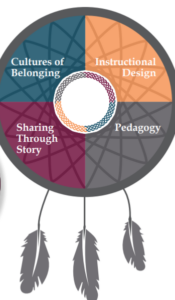Educators respect and value the history of First Nations, Inuit and Metis in Canada and the impact of the past on present and the future. Educators contribute towards truth, reconciliation and healing. Educators foster a deeper understanding of ways of knowing and being, histories, and cultures of First Nations, Inuit and Metis.
Although this summer has been extremely busy, I made the vow to myself to read literature that was created by Indigenous authors so I can go into my future classrooms with a variety of experiences through reading. One of the books that I read may just help me relate to a student that is having a difficult time. Along with reading books of different styles I have been researching ways I can be more inclusive and embrace diversity in a way students can actually see. How can I make my classroom a “whole”?
“As instructional designers, educators empower students to
connect deeply to learning outcomes through the experiences
they create.” ( Weaving Ways, 2018, P. 7)
This quote by the Alberta Regional Professional Consortium has stuck with me because it involves creating and I want students to learn through there own experiences. On top of this, If I, as an educator, can create deeper learning by helping students explore multiple cultural perspectives I would call that a success for me. There is power in words and they are even more powerful when they are written from experience and if students are open minded to the feelings and discomfort they bring the learning will never stop.
The first step I have learned through my summer of reading is to teach respect in the classroom because it is the basis of teaching that we are all equal and no one is better or worse than another, we are all human and need to have respect and compassion for each other. A very VERY important differentiation I had to learn was the line between practicing versus teaching about culture. A question I can refer back to through my future years of teaching is, “If I were a member of the group in question, could I be offended?” Take history into account, and show empathy.
An automatic starting place is usually history and the horrors that it produced but after all the information I have sifted through, cultural genocide and residential schools are not the place to begin teaching because Indigenous people are not victims first, it is not what defines an entire cultural group because every part is different. We must take the time to learn about all aspects and learn about the proud and resilient people who survived a terrible time but used their experience to teach future generations. As I have learned through the program already it is important to invite Indigenous people to speak for themselves. Inviting local Indigenous knowledge keepers into the classroom is an opportunity to forge new and ongoing relationships. If an Indigenous person cannot be present, there are excellent and well-vetted videos available.
I have and will continue to learn about holistic ways of teaching and teaching with stories and through story telling because it has always been inside me but I never knew I could use these skills in teaching.
“Tell me the facts and I’ll learn. Tell me the truth and I’ll believe.
But tell me a story and it will live in my heart forever.”

Alberta Regional Professional Development Consortium. (2018, September). Weaving Ways. Education for Reconciliation . https://empoweringthespirit.ca/wp-content/uploads/2018/09/Weaving-Ways-Introductory-Document-10-09.pdf.